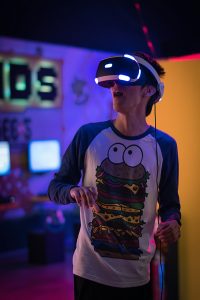It’s the most wonderful time of the year. Not just because marketers everywhere are looking to take a well-earned rest and wind down as we lead into the festive season, but because it’s the time to make predictions for the future of tech & digital marketing, and to plan your experiences to accommodate them in the new year.
There is no doubt that the economy (both in the UK and globally) is rather unstable and, in many ways, scary right now. Meaning consumers are taking extra consideration when it comes to any spending decision, personally or professionally. It’s therefore understandable that some business leaders may choose to “play it safe” by looking at options to reduce overall business spending, or at least maintain current spend levels.
However, with customer-facing technologies, it really should be a different story. When experiencing an uncertain economy, brands are actually presented with some significant opportunities for investment that can ultimately differentiate businesses, delivering memorable positive experiences, leading to increased operational efficiencies as well as new customer acquisition and loyalty.
So, here’s a round-up of some of the digital experience & marketing trends to look out for in 2023.

This will likely seem like a bit of a no-brainer to many of you reading this and it certainly does to us as one of our core mantras is to ‘deliver remarkable customer experiences that convert’. However, for many brands CX (customer experience) & DCX (digital customer experience) just hasn’t been at the forefront of their agenda, or it has been masquerading as different, silo’d ventures into user experience, customer service, marketing and so on…
A study by innovative CX/tech research firm Metrigy reports that “CX is the number one priority for companies increasing their technology spend during 2023, with 65% of companies planning to do so – by an average of 24 percent”. In addition, the study showed that no other technology area garnered a higher number of companies with planned increases in spending. In fact, despite the current economic uncertainty, only 9.6% of companies plan to decrease their CX spending, the lowest of any technology category measured in the report.
There’s more evidence that brands and businesses will be prioritising CX so highly in their plans for 2023. Research from PWC found that 73% of consumers rank CX as an important factor in their purchasing decisions (as you’d expect in current times, “price” and “product quality” were the only factors which ranked more highly). Consumers are also willing to pay a 16% price premium for a great customer experience. The same survey also demonstrated that within CX, “speed, convenience, ease-of-use and friendly service” are the most important elements. So, it makes sense that any tech-driven initiatives aimed at improving CX in 2023 should prioritise these key attributes.
There’s no denying that Covid-19 accelerated the adoption of tech and migration of experiences into the digital space, which led to brands having to pivot and adapt rapidly, creating new and exciting tech stacks in the process. As a result, there’s an ever-expanding plethora of customer-facing technologies that can live under the umbrella of “CX”. Improving all of these systems, tools, interfaces & platforms to reduce friction really can enable you to give customers what they want, where they want it, when they want it, how they want it. From a digital perspective, this will continue to include tools like websites, social media and chatbots but will increasingly take in exciting emerging channels such as the metaverse and augmented/mixed reality (we’ll come on to this shortly).
Making sure all these different technologies work together is important and delivering a consistent customer experience across all touch points is absolutely vital (which is why both our Experience Design and Experience Marketing teams work so collaboratively at Sagittarius).

Lauded as one of the big trends for 2022, but continuing to baffle everyone at any level of digital maturity, the Metaverse is set to be on the agenda again in 2023. The metaverse is often defined as a “collective virtual shared space, created by the convergence of virtually enhanced physical reality and physically persistent virtual space, including the sum of all virtual worlds, augmented reality, and the internet”. In the metaverse, users can interact with each other and with virtual objects and representations of real-world objects in real-time. The concept of the metaverse has been explored in science fiction for many years and has recently gained renewed interest as virtual and augmented reality technologies have advanced. Some people see the metaverse as a potential future platform for various types of social interaction, education, and entertainment. Savvy brands already see it as a potential platform for economic activity, with virtual goods and services being traded and sold within the metaverse.
Yet to really manifest in a solidified format with a unified definition, it’s fair to say the Metaverse is disjointed. For the typical consumer right now, it really just covers the digital spaces in which users can game, interact and live more virtually such as Roblox and Fortnite, but is likely to be much better defined in the next 5-10 years. Whilst immature, there’s no denying the exciting and immersive experiential opportunities available within metaversal technologies from a marketing perspective right now. 2023 might just be the year to explore these.
In addition to the activations in Roblox and Fortnite, some purpose-built metaverse platforms such as The Sandbox, Decentraland or Meta Horizons have been experimented with by brands like JP Morgan, Wendy’s and Fender.
The research clearly demonstrates that consumers increasingly want their relationships and interactions with brands to be memorable and experiential. This means that brands that want to stay relevant and successful in 2023 will have to create customer journeys that are thoughtful, memorable experiences.
These experiences don’t have to be just transactional, many of the early forays into the metaverse for brands have been to create something new and exciting, to build buzz and create conversation about the brand – almost guerilla-like in their experiential tactics, focussing more on brand awareness in these spaces than directly influencing sales. The Metaverse is clearly one of the most exciting opportunities to achieve this, and with early adoption ripe for the picking, brands who can experiment and learn at this early stage will be setting themselves up for success in the future as it becomes more established.
Recently, Sitecore surveyed consumers & marketers to explore the metaverse’s potential. Interestingly, when consumer survey respondents were asked how they would use the Metaverse, the most popular responses included “an event, concert, or festival” (43%), “to tour a home when looking to rent or buy a property” (37%), and “to try on shoes, clothes or makeup before purchasing” (37%). For the marketers, 90% agree that the future metaverse can help solve unique business challenges. They also believe the metaverse will be able to help with brand building, including awareness (68%), customer engagement/loyalty (59%), and reputation (49%). More than half (54%) see sales and revenue potential.
We can also see the metaverse as an opportunity to develop hybrid approaches to activations and experiences beyond those solely in virtual reality – there are also opportunities through the use of augmented and mixed reality.

Where Virtual Reality (VR) lives completely digitally, Augmented Reality (AR) is a type of technology that superimposes digital content onto the real world. It involves the use of devices such as smartphones, tablets or even smart glasses to display digital information on top of the physical environment, providing an enhanced view of the real world.
Mixed Reality (MR) is a type of technology that combines elements of both virtual reality (VR) and augmented reality (AR). It usually involves the use of devices such as headsets or glasses to create an immersive experience in which digital content is seamlessly integrated into the physical environment.
Both of these represent some interesting opportunities. More obvious and established uses include using VR to tour properties, hotels, showrooms and even cars, adding immersion to the experience at ‘arms length’ when a physical location visit is not possible. Further developments include creating new digital advertising styles through augmented reality billboards and interactive call-outs overlaid in the real world; to the ability to try on clothes or make-up virtually. Nike have even coupled this with the rise in NFT usage, creating some amazing virtual clothing NFTs through AR through their web3 studio, RTFKT.
Exploring applications across all varieties of realities will be experimental at first, but many will become ‘the norm’ and mainstream

Personalisation enables brands to tailor marketing messages and campaigns to individual consumers based on their personal characteristics, preferences, and behaviours and can be achieved through various channels, such as email, social media, PPC, mobile apps, and websites.
Personalisation improves the customer experience by providing relevant and personalised content, recommendations, and offers to individual consumers. It can also help businesses increase conversions and sales by targeting their marketing efforts to specific groups of consumers who are more likely to be interested in their products or services.
There are several ways that personalisation can be implemented through digital experience marketing, including using customer data to send targeted emails with personalised subject lines, content, and offers; to using customer data & behaviours to tailor website content and recommendations to individual users.
Zoe Allen, CRO and Personalisation Lead at Decathlon recently spoke at the CX Conference: “The way most brands are segmenting their audiences online is obsolete,” says Zoe. She believes we need to go beyond demographics to improve CX for the average user.
“The problem is there’s no such thing as an average user,” says Zoe. So, when it comes to segmenting, businesses should look at audience behaviour, not their attributes. “Because our demographics don’t define who we are; our actions do.”
This is, of course, personalisation’s sweet spot. A user browses content on a certain topic or theme, or interacts with certain products, or even comes from a certain campaign and we know what content we need to present to them to nurture their next action, on what channel and with what messaging to resonate with the greatest impact.
Personalisation doesn’t solely live in the digital world. Many brands are using their digital platforms to go beyond personalised marketing, enabling customers to personalise their physical products at point of order through eCommerce, often using AR and AI. Some great examples include everything from trainers such as those available through Nike’s ID (Nike By You) platform; to personalised clothing subscriptions like Stitchfix and Lookiero; through to skincare brands like Clinique, who offer personalised moisturisers which are specifically tailored to customers’ skin.
No matter the stage in the customer journey, personalisation can positively impact businesses & improve the effectiveness of their marketing efforts by delivering more relevant and personalised experiences to their customers. However, to deliver a truly personalised omni-channel experience, it’s vitally important that users are met with the same personalised messaging across all channels. Ensuring a customer can be targeted with personalisation at every touchpoint is going to be a huge part of activity in this area next year with the limitations being placed on cookie/pixel tracking, making first-party data, tracking & personalisation capabilities (like those within Sitecore) even more important.

A DXP, or Digital Experience Platform, is a software solution that helps organisations create and manage digital experiences for their customers. These experiences can include websites, mobile apps, social media platforms, and other online touchpoints. DXPs provide a range of tools and capabilities, such as content management, customer relationship management, analytics, and personalization, to help organisations deliver engaging and relevant experiences to their customers.
DXP solutions are designed to help brands improve customer engagement, increase conversions, and drive revenue growth through the creation and management of personalised, data-driven digital experiences. Large enterprises and organisations often use them with complex digital landscapes and a need for robust, scalable solutions to manage their digital experiences.
There’s been accelerated development in the DXP space in 2022, with the buzziest of the buzzwords being “Composable” and “Headless”. According to CMSWire, “A composable DXP is essentially a best-of-breed digital ecosystem with complementary SaaS, cloud-native tools from multiple providers stitched together through APIs and data flows. Composable architecture offers a more flexible and agile approach to delivering customer experience, avoids vendor lock-in and allows teams to evolve a system with the tools they love.”
“In 2023 it’s likely that vendors will continue to offer cloud-native services with APIs that can fit into a composable DXP, and that more customers will start to evolve their composable systems. But we’ll also start to see more products emerging similar to Sitecore Connect that contribute an orchestration layer and make it easier to achieve a composable DXP in practice.”
This support for a more composable stack opens the door for further advancement in headless. Headless website development is an approach where the front-end of a website is “decoupled” (separated) from the back-end, or content management system (CMS). In a headless website, the front-end is implemented as a separate client-side application that communicates with the back-end via APIs to retrieve and display content. This allows the front-end and back-end to be developed and managed independently, which can be beneficial in situations where the front-end needs to be updated frequently or where multiple front-ends are needed to support different devices or platforms.
One advantage of headless website development is that it allows brands to create highly customised, personalised and interactive user experiences without being constrained by the capabilities of their CMS. It also allows them to easily update and maintain the front-end of their website without affecting the back-end, which can be particularly useful for large organisations with complex digital landscapes. Support for headless publishing through Sitecore is now making it far more achievable to harness the power of publishing the same base content across multiple experiences across multiple channels through a more accessible system for storing, accessing & distributing your content. The benefits of headless are clear to see. Exciting times.
Whilst the 5 headline trends outlined above are fundamental in 2023, there will be other trends to watch out for:
2023 is looking good!
So, 2023 is undoubtedly looking full of digital and experience marketing opportunities. According to Nasdaq, nearly every shopping purchase (95%) will happen online by 2040. Now is the perfect time to get ahead of the curve and push the needle towards establishing digital dominance.
If you’re thinking of adopting any of the new tech opportunities outlined above to drive your strategy forwards in 2023, why not get in touch with our team of expert Experience Designers, Marketers and Developers.